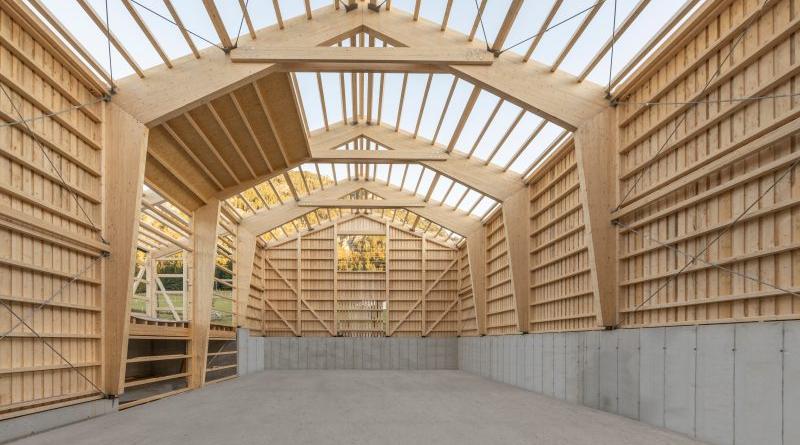Which material will become Europe’s future construction mainstay?

his article is part of our special report Is there a role for concrete in sustainable construction?.
The European Union’s construction industry stands at a crossroads: In its transition to a climate-neutral ecosystem, the incumbent industry is worried that organic replacements are given disproportionate support.
Construction is a big business. According to European Commission data, the sector employs around 25 million people and generates an added value of €1,158 billion per year.
On the flip side, construction is responsible for 50% of material use and about 35% of waste and emits about one-third of the EU’s total CO2 – both during construction and when the buildings are lived in.
Tackling this two-sided construction and buildings challenge is very much on the mind of Brussels policymakers.
In March, the Commission presented its “transition pathway for the construction ecosystem,” laying the foundation for the sector’s eventual digital and green transformation. The Brussels push is accompanied by initiatives like the New European Bauhaus.
No one knows what this transformed sector, future houses, will look like. Some experts say houses will become Lego-like material repositories, and traditional environmentalists eye a future where wood plays a bigger role.
The prospect of being replaced by wood-based materials has the traditional mineral construction product industry – think concrete, ceramics, cement and mortar – rather worried.
Such products make up about 5% of the worldwide total greenhouse gas emissions, more than double that of the global container fleet of 6,000 huge ships, the backbone of international trade.
Today, cement is said to be the second most-often consumed product, beaten only by water.
But production of cement is damaging to the climate as it is ultimately dusted limestone and clay heated to temperatures as high as 1450 °C.
Generating that heat to force carbon out of the raw materials produces extra carbon, while also deeply altering their chemical bonds, creating “clinker”.
The changes leave clinker extremely ready to form strong structures when mixed right, forming concrete with widespread application in construction.
Can timber fix the issue?
Could wood and other bio-based materials help fix the sector’s climate issues?
The EU-supported Intelligent Cities Challenge initiative aims to spread best building practices across the EU, one example being Amsterdam’s local mandate that all new housing projects must contain 20% timber.
Similarly, an ongoing development study, aimed at “outlining how all building-related emissions can be mitigated by 2050” and funded by the European Commission, eyes “full timber structures in new construction” and other roles for timber.
However, to counter the common narrative that “an increased use of biobased products is the simple solution, a short-cut route for transforming the construction sector”, six EU industry associations commissioned a separate study.
The study is supported by Cerame-Unie, the voice of the European ceramic industry, and various concrete associations gathered in Concrete Europe, as well as the European mortar industry organisation and the European brick lobby ECSPA.
Its broad meta-analysis found that “the use of forest products in construction has a discernible abatement potential in climate change mitigation”, but added that the perceptible impact of this is “relatively limited”.
The study similarly questioned another benefit of wood-based construction often touted by its proponents, namely its ability to act as secure carbon storage.
“In order to have any benefits from temporary carbon storage in timber, carbon neutrality through sustainable forestry and parallel active reforestation are unequivocal prerequisites,” the study found. These are currently not a consistent given.
Their findings are supported by nature advocates, who commonly decry the unsustainable nature of logging activities. Green lawmakers blame forestry-oriented EU countries for blocking reform to boost the sustainability of logging.
Katharina Blümke, a sustainable construction researcher at the Karlsruhe Institute for Technology, said that “building with wood is one possibility, but it is not the panacea. We can’t just say we’ll build everything in wood, and then we’ll have solved all the problems”.
Blümke’s fellow researcher Elena Boerman added: “We will never be able to do without concrete, at least as things stand today.”
One way to boost concrete’s green credentials is through “real concrete recycling”, Boerman highlighted but added it was a challenging process largely deemed unfit for real-world application.
The cement industry instead touts carbonation – a process whereby concrete sucks up carbon from the air – as a climate upside. According to an industry-backed study, the carbonation of cement “represents a large and growing net sink of CO2,” meaning that the entirety of consumed cement absorbs up to 300 to 800 million tonnes of CO2 per year on a global scale.
However, betting on carbonation would be an about-turn for the cement sector.
“The industry has spent decades trying to reduce it because it generally degrades the concrete,” said Robbie Andrew, a senior scientist at the CICERO Center for international climate research.
As lobbying Brussels gets in full swing, a final ruling on what materials will go into future construction products still appears quite out of reach.
[Edited by Nathalie Weatherald/Zoran Radosavljevic]
cover photo: Competition from timber has the incumbent construction industry worried. [Shutterstock/a4ndreas]





